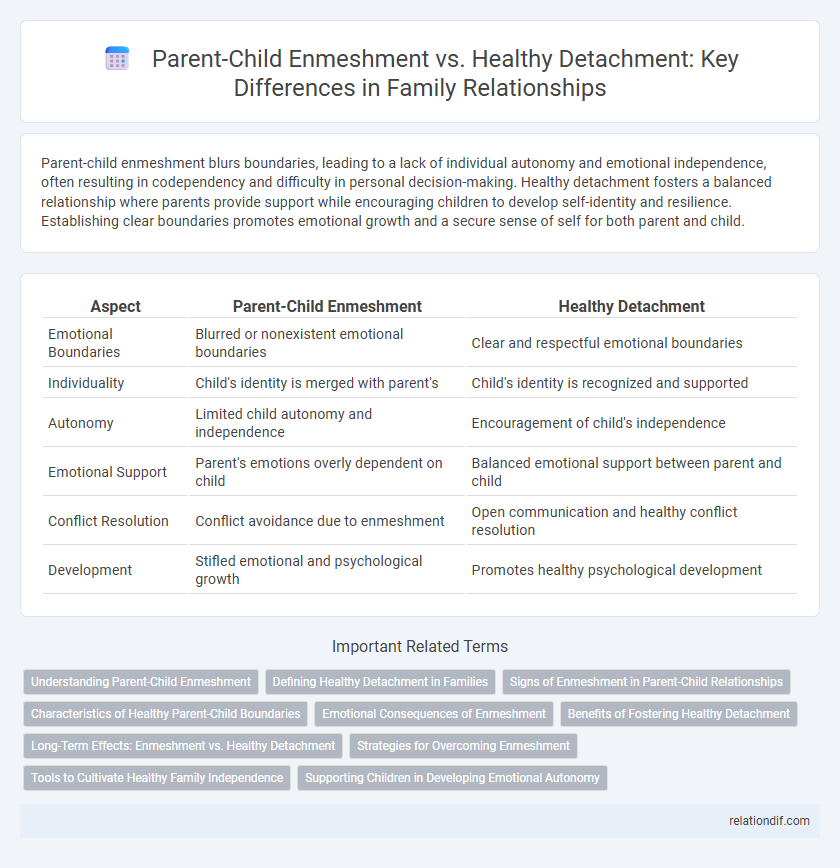Parent-child enmeshment blurs boundaries, leading to a lack of individual autonomy and emotional independence, often resulting in codependency and difficulty in personal decision-making. Healthy detachment fosters a balanced relationship where parents provide support while encouraging children to develop self-identity and resilience. Establishing clear boundaries promotes emotional growth and a secure sense of self for both parent and child.
Table of Comparison
| Aspect | Parent-Child Enmeshment | Healthy Detachment |
|---|---|---|
| Emotional Boundaries | Blurred or nonexistent emotional boundaries | Clear and respectful emotional boundaries |
| Individuality | Child's identity is merged with parent's | Child's identity is recognized and supported |
| Autonomy | Limited child autonomy and independence | Encouragement of child's independence |
| Emotional Support | Parent's emotions overly dependent on child | Balanced emotional support between parent and child |
| Conflict Resolution | Conflict avoidance due to enmeshment | Open communication and healthy conflict resolution |
| Development | Stifled emotional and psychological growth | Promotes healthy psychological development |
Understanding Parent-Child Enmeshment
Parent-child enmeshment occurs when boundaries between parent and child are blurred, leading to a loss of individual autonomy and emotional independence. This dynamic often results in the child's identity being overly tied to the parent's needs, impeding healthy psychological development. Recognizing enmeshment involves observing patterns of excessive emotional involvement and dependency, contrasting significantly with healthy detachment where clear, respectful boundaries support the child's self-growth.
Defining Healthy Detachment in Families
Healthy detachment in families involves parents respecting their child's individuality while maintaining emotional support and clear boundaries, fostering independence without emotional cutoff. This balance prevents enmeshment, where blurred boundaries lead to overdependence and hinder personal growth. Establishing healthy detachment promotes resilience, self-identity, and positive parent-child relationships essential for emotional well-being.
Signs of Enmeshment in Parent-Child Relationships
Signs of enmeshment in parent-child relationships include an absence of clear boundaries, where a parent's emotions and decisions heavily dictate the child's feelings and choices, leading to role confusion. Children often struggle with autonomy and express difficulty in making independent decisions, showing excessive dependence on parental approval. Emotional overinvolvement causes the child's personal identity to blur with the parent's, undermining healthy psychological development and fostering codependency.
Characteristics of Healthy Parent-Child Boundaries
Healthy parent-child boundaries promote individual autonomy while maintaining emotional connection, ensuring respect for personal space and privacy. These boundaries involve clear limits on responsibilities, enabling children to develop self-identity and decision-making skills free from parental over-involvement. Emotional regulation within these boundaries supports mutual trust and encourages open, respectful communication.
Emotional Consequences of Enmeshment
Parent-child enmeshment often leads to blurred boundaries, causing children to struggle with identity and independence, which in turn results in anxiety, depression, and low self-esteem. Emotional consequences include chronic feelings of guilt, difficulty managing personal emotions, and an impaired ability to form healthy relationships later in life. In contrast, healthy detachment fosters emotional resilience, autonomy, and secure attachment patterns essential for psychological well-being.
Benefits of Fostering Healthy Detachment
Fostering healthy detachment in parent-child relationships promotes emotional autonomy, allowing children to develop self-confidence and resilience. This balance supports open communication and trust, enabling children to explore their identity while feeling secure in the parental bond. Healthy detachment reduces dependency and conflict, contributing to long-term mental well-being and stronger family dynamics.
Long-Term Effects: Enmeshment vs. Healthy Detachment
Long-term effects of parent-child enmeshment often include impaired emotional boundaries, low self-esteem, and difficulties in forming autonomous adult relationships. In contrast, healthy detachment fosters secure attachment, emotional resilience, and independent identity development over time. Establishing clear, balanced boundaries contributes to psychological well-being and relational stability across the lifespan.
Strategies for Overcoming Enmeshment
Establishing healthy boundaries and encouraging open communication are essential strategies for overcoming parent-child enmeshment. Parents and children can benefit from individual therapy to develop separate identities while maintaining emotional connection. Practicing emotional regulation and fostering independence support healthier detachment, promoting balanced relationships and personal growth.
Tools to Cultivate Healthy Family Independence
Setting clear boundaries and encouraging open communication are essential tools to cultivate healthy family independence while preventing parent-child enmeshment. Promoting individual interests and respecting each member's autonomy fosters emotional resilience and personal growth. Regular family activities that balance togetherness with personal space reinforce a supportive yet independent family dynamic.
Supporting Children in Developing Emotional Autonomy
Supporting children in developing emotional autonomy involves fostering healthy detachment by encouraging independent decision-making and validating their feelings without imposing parental expectations. Parent-child enmeshment often blurs boundaries, leading to dependency and difficulty in self-regulation, whereas healthy detachment promotes resilience and emotional self-awareness. Establishing clear boundaries and consistent emotional support helps children build confidence in managing their emotions and relationships independently.
parent-child enmeshment vs healthy detachment Infographic

 relationdif.com
relationdif.com